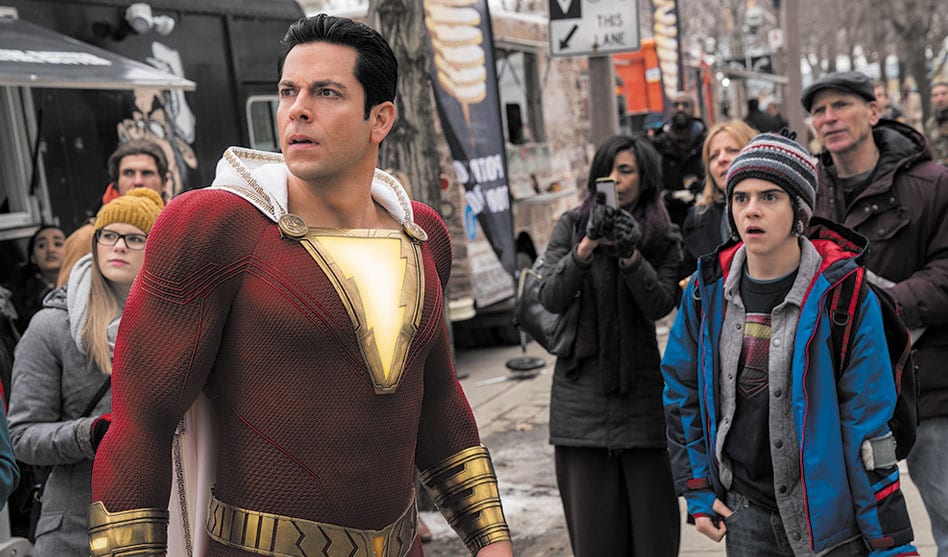Zach Levi plays the muscular but still immature incarnation of teenager Billy Batson (alongside Jack Dylan Glazer) in the problematic ‘Shazam.
The conundrum that is ‘Shazam’
ARNOLD WAYNE JONES | Executive Editor
jones@dallasvoice.com
Shazam is a “not” movie — one of those Hollywood studio productions more defined by what it isn’t than what it is. It is not, for example, a kids’ movie — too gross, too sexual, too violent — but nor is it for adults — too childish, too banal, too cartoony. (It’s also too homoerotic for tweens, and not homoerotic enough for gayboys.) It isn’t a comedy per se, though its light-heartedness removes it squarely from the action category. (Imagine Deadpool Lite.) It’s not an outright magic movie like Harry Potter, or an outright superhero movie — it’s closer to spoofs like Super, Mystery Men or The Tick, with lots of meta-references to other comic book characters.
It’s not good. But it isn’t bad.
Generating any real feelings for Shazam is a huge problem for it. Though technically part of the DC Extended Universe, it is being released by New Line Cinema, a smaller imprint of Warner Bros. That even glazes it with the patina of a red-headed stepchild… which, in terms of the plot, isn’t far from the truth. Billy Batson (Asher Angel) is a foster kid who has run away from too many group homes to count, always in search of the mom who lost him at a carnival a decade before. He finally ends up with a new family, a warm hodgepodge of good kids who seem to have few troubles… and just ethnically diverse enough to play to all demographics (they might as well have called it United Colors of Foster Homes). Billy bonds with the other white boy about his age, Freddy (Jack Dylan Grazer), just as Billy is “chosen” by a wizard’s spell to take on the attributes of Solomon, Hercules, Atlas, Zeus, Achilles and Mercury — whose acronym becomes his character and his war cry: Say “SHAZAM,” and become a mid-30s superhero (Zachary Levi), clad in Spandex and a white cape that must be a bitch to keep clean.
Underneath padded muscles, though, is still a 14-year-old kid, who seems to have skipped over the “wisdom of Solomon” in his incantation. And so for most of its runtime, Shazam is just Big Meets Superman. (The just-marginally-competent director, David F. Sandberg, even adds a scene in a toy store with a “dancing keyboard,” just to hit home on the theme. This is not a movie that traffics in subtlety.)
The character of Shazam — originally named Capt. Marvel, but let’s not cloud those skies right now — was a better version of the boy inside, not merely a stronger one. The plot basically betrays the entire theme of the comic (even posited in the movie) that only the purest soul can attain these powers. It seems like Billy just happened to be closest when the telemarketer called.
That’s just the tiniest of the knotty problems in this movie, which feels so divorced from reality that even when bullies run over a disabled kid with a truck, nobody — not a teacher, not a parent, not another student — seem to register the felony that just occurred. Tragedies befall, and disappear, like sand. The film aggressively avoids any consequences, like a story written by a first grader. At one point, the villain throws corporate executives out of the upper window of a skyscraper to their bloody deaths… and yet cops don’t seem to notice (they do, however, respond to an anonymous tip about drug dealing at a pawn shop, and track down truants like they are Pinkerton agents).
But despite its appalling sloppiness, it’s also difficult to dislike Shazam with much enthusiasm. I can’t fathom the target audience for the film, but I don’t feel it’s filled with ill-will, just misguided detritus. The actors are appealing enough, and near the end, when superhero versions of the foster kids appear, I did find myself marveling at the beefcake… Sorry, DC’ing at the beefcake? Shazaming? Whatever.












